Before I explain what this sexy beast and constant sentry of a traffic control device is all about, I’ve got to holler about something for a minute.
Connecticut simply cannot get out of its own way.
Currently, if one is trying to cross the street, the motorist is required to yield when the pedestrian is in the crosswalk.
For those who are not wordsmiths, you may have skipped right over the word “in” or not thought about what this feels like when practiced.
It means that as a pedestrian in this state, you can stand on the curb all day waiting, but drivers are not required to stop to let you cross unless you step off the curb and into the crosswalk.
If you’re thinking that it’s bonkers to expect a vulnerable user to throw herself into the street in order to get the legal right to cross, you’re not alone.
Last year, there was an attempt to make our laws less terrible. Cristin McCarthy Vahey, a State Representative from Fairfield, introduced a bill that would require motor vehicle operators stop when a pedestrian approaches a crosswalk. This change would have addressed both safety and equity. The bill made its way out of committee. The House passed it through. Then, it stalled, having sat with the Senate for one month without a vote.
(Anyone reading this who is unconvinced of its necessity is personally invited to try crossing the messy intersection at Park Terrace/Sigourney. Be sure to comment if a single driver yields to you. This has not happened for me once, and I use this intersection almost daily.)
No problem has a single answer, though fixing broken laws is a start.
A 2014 article from Portland, Oregon described Rectangular Rapid Flash(ing) Beacons as the “safety tool of the moment.” Hartford got its first one by summer 2017 on Market and Pequot streets, where Travelers employees cross to get to their parking lot behind Candlewood Suites.
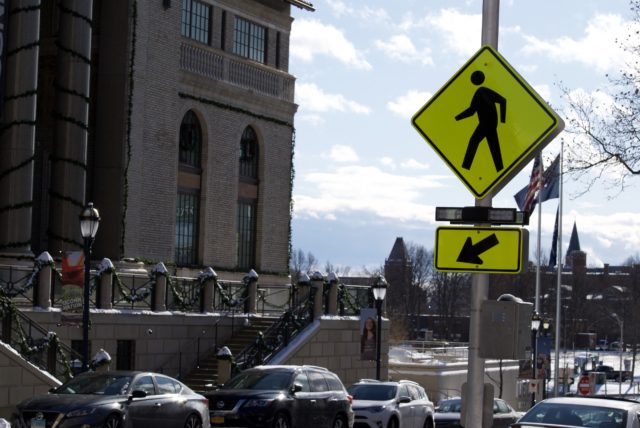
More were added in late 2019 on Prospect Street between UConn and Burr Mall. Unfortunately, one of the signs was installed such that in season, it is obscured by a street tree. It is also partially blocked by a banner.
This addition came at the time that a crosswalk was re-installed. Re-installed? Yes. The existing one had been removed intentionally by Hartford’s Department of Public Works when the road was repaved the year UConn opened.
It’s possible to simultaneously applaud progress while maintaining irritation at needless setbacks and long delays.
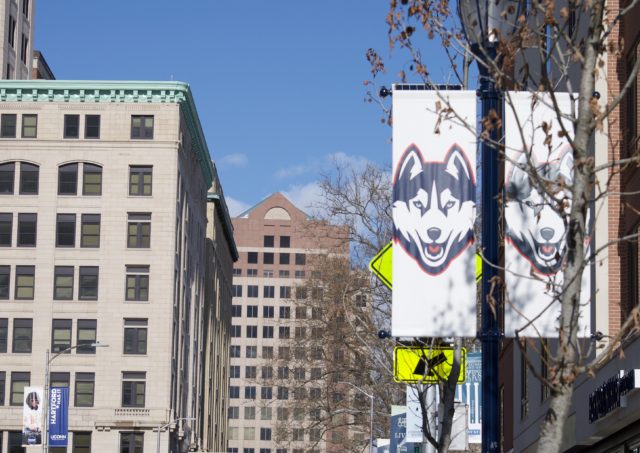
Two more crosswalks were recently amended to include RRFBs. Both are near the newly constructed State of Connecticut parking garage (Buckingham Street) and renovated State Office Building (165 Capitol Avenue).
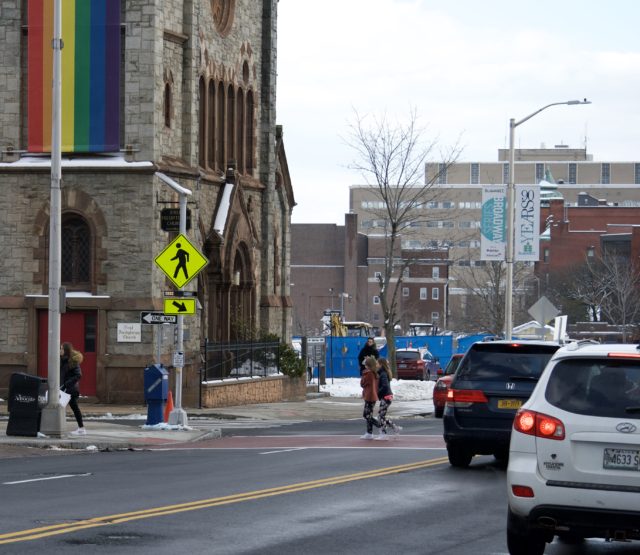
It’s a little weird that all of Hartford’s RRFBs have been installed to assist pedestrians going to and from parking, with the exception of the crosswalk on Prospect Street by UConn and Burr Mall.
But, what are these fancy lights?
Chances are, if you are behind the wheel of a car, these devices were not part of your driver’s education. Actually, they do not appear to be included in the current driver’s manual either.
Rectangular Rapid Flash Beacon (RRFB) AKA LED (light emitting diode) Rapid Flash System AKA LED beacons are electronic crosswalk signs placed at marked, unsignalized intersections or mid-block crosswalks. Unlike the standard beg buttons at intersections around Hartford, RRFBs are quickly activated when a person presses the button. When activated, they feature an irregular or stuttering flash pattern.
While the flashes may be irregular and attention-getting, they are regulated as to not trigger seizures.
Here’s why they’re cool: they work.
A Western Michigan University study from 2011 found that use of RRFBs lowered by 20% the number of vehicles traveling above 41 mph.
A collision at a lower speed is less likely to severely injure or kill a pedestrian; vehicles traveling slower are also, simply, more capable of avoiding a collision in the first place.
These were also tested in St. Petersburg, Florida. In crosswalks without beacons, as few as 18% of motorists bothered to yield to pedestrians. When the LED beacons were added, motorists yielded to pedestrians as much as 88% of the time. Other studies showed that use of RRFBs produced driver yield rates of 96%.
There are two pieces of information to glean from that. First, my fellow pedestrians, it is not our imagination that people don’t want to let us cross the road. Second, if these work so well and are so inexpensive when compared to the more traditional traffic light systems (traditional feels like a weird word to use about cars), why has Hartford been so slow to adopt them?
Besides Hartford (and Connecticut’s) reluctance to try new things?
Traffic engineers have a reputation for not liking deviations. There are standards and the standards must be followed. It’s awfully inflexible, and in some cases, I would argue that uniformity and predictability causes problems.
In any case, the Manual on Uniform Traffic Control Devices (MUTCD), which sets standards for traffic engineers to follow, gave “interim approval” for these devices in 2008, as their size and shape did not comply with MUTCD’s standards. RRFBs were allowed in certain situations, but there were all kinds of stipulations around their use. Basically, engineers acknowledged that the LED beacons were awesome, and that they might need to revise their MUTCD standards for the devices to be fully approved.
Not long after, the equipment was patented, privately. Soon after, unauthorized copies were produced and installed.
In Cook County, Illinois, during the summer of 2016, a cyclist in a crosswalk was killed after a motorist operating a Lexus SUV did not yield to her. That cyclist had activated the beacon before crossing. The driver was not wearing corrective lenses, passed another vehicle that was stopped at the crosswalk, did not stop or reduce speed, and was going 40 mph in a 30 mph zone. That driver received only a $150 fine. In 2016, a cyclist’s life was valued at $150. Her husband was not satisfied with this outcome, and filed lawsuits against the driver and the town (technically villages or something, but don’t miss the point). What could the town be sued for? “Carelessly and negligently” designing a crosswalk that used two beacons instead of the three that the manufacturer had recommended. The driver’s insurance company eventually settled on behalf of the motorist. Following this, there was an attempt by the Illinois state senate to pass a bill that increased punishment for motorists who did not yield to people in crosswalks, causing serious injury or death.
Part of the discussion around this bill was about how RRFBs use a yellow (amber, technically) light, which drivers may interpret as a warning, not a command. Here in Connecticut, the DMV’s Driver’s Manual (revised 2019) explains that a yellow traffic light means “the traffic light is about to change to red. You must stop if it is safe to do so. If you are in the intersection when the yellow light comes on, do not stop-continue through the intersection.” That should be obvious, but anyone familiar with Connecticut behaviors knows that the yellow is often interpreted as “speed up before you get stuck having to, heaven forbid, give other people a turn.” A flashing yellow light, by law, in this state, means “slow down and proceed with caution,” which again, is not heeded with any regularity.
The RRFBs are part of a yellow diamond sign, which is a sign of warning that communicates to drivers that they should proceed with caution and be ready to slow down. Though they never change to red lights, common sense would dictate stopping; regardless of light color, motorists are expected to yield to pedestrians who are within any kind of crosswalk.
Back to the RRFBs, by the close of 2017, interim approval was terminated because of a patent dispute issue. The Federal Highway Administration does not allow patented devices in the MUTCD, and if it’s not in the MUTCD, good luck getting the device installed by your city or state.
If you ever wondered what the hold up was on having life-saving technology, ask yourself, are there wacky lawsuits going on?
In 2018, Carmanah Technologies, headquartered in Canada, purchased and disclaimed all patents restricting RRFBs. For those who don’t speak patent language, this means that they bought up the intellectual property and then cancelled their right to it, putting the design into the public domain. The Federal Highway Administration in March 2018 reissued its interim approval following this move.
Anyway, we have a few now, and what people need to know is that when the lights are flashing, motorists need to let pedestrians safely cross.
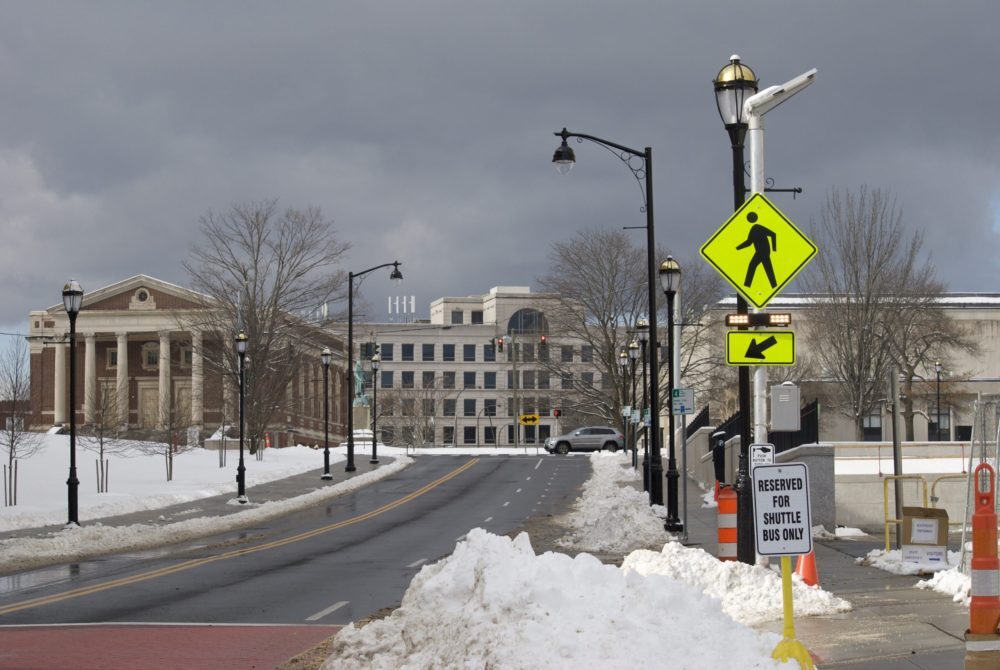
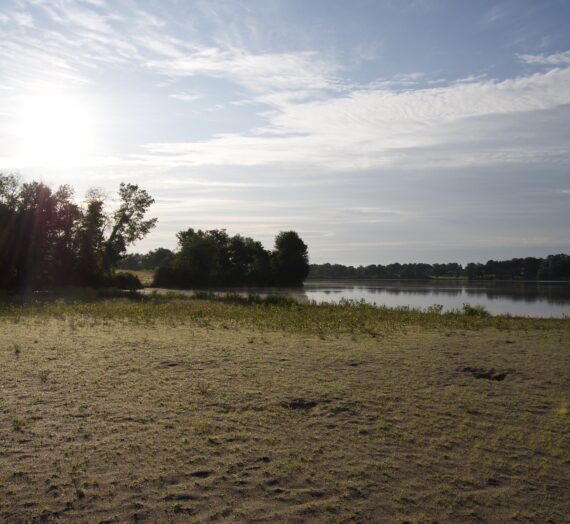
Peter Brunelli
I park in the Buckingham garage and even with the flasher it is a bad place to cross. It is next to the garage entrance/exit, the side entrance to 165, the parking for the shuttle bus, and the street side parking on the westbound side of Buckingham. Maybe the congestion will improve once the construction is over, but it is still in an area where cars are trying to make the light at Washington, or coming down the hill from the light. The situation is the same at the Capitol Ave crossing by Clinton, the Elm St crossing, the crossings at Jewell to Ann Ucello street… I’ve had cars pass vehicles stopped for pedestrians at all three of those. The crossing at Jewell is the worst. Cars coming from the west like to blast the horn and tell pedestrians to get the f out of the road. Multiple signs and a painted crosswalk just create false security in the pedestrian. Drivers could not care less. Bluntly, Hartford is made for cars, and pedestrians will always get the stinky end of the stick. Forget cyclists. The city couldn’t do more than a little paint on the road, and all the Lime bikers rode on the sidewalk because the streets are deadly. Until Hartford stops letting LAZ and ProPark run the city there will be no significant improvement.
Kerri Provost
EVERYTHING you just said!
Having additional lights does not hurt to grab the attention of drivers, but it only helps if drivers are actually looking out and if the signs aren’t obscured. I kept wondering why I would activate the light at Prospect Street and see so few cars stop…then I came at it from a different angle and saw that the flashing light was blocked by the UConn banner and a tree! It’s like the iQuilt signs that have been recently installed which block the pedestrian walk signals.
Good for Hartford for taking a tiny step forward…but now do all the other things that would be more meaningful, like narrowing streets so these wild speeds are less possible to achieve.
Peter Brunelli
Maybe the worst example is the crosswalk between the State Library and the Capitol. As you travel west on Cap the crosswalk lights line up with the lights at the 84 entrance, and the sightline makes the crosswalk lights hard to see. Everything else is ok, including the super-fast response time for the button, but you see drivers either late to recognize the traffic light or just blowing through while you are in the crosswalk (some even shrug/wave). I cringe every time I see a herd of school kids using that crosswalk.